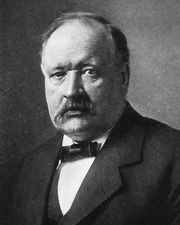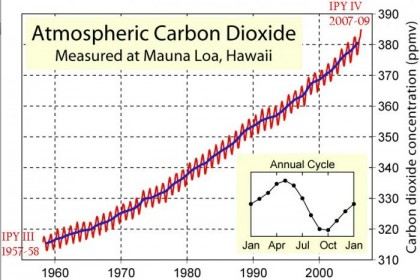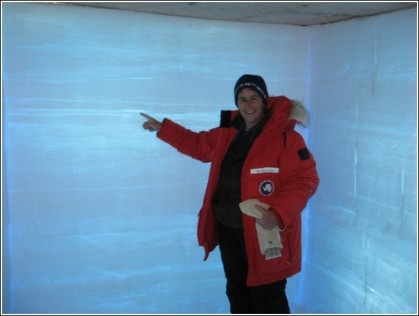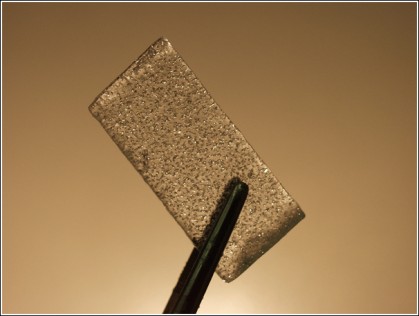19 December 2009
Ice Cores and Copenhagen- The Connection
Posted by Dan Satterfield

The WAIS Building where the ice core drilling is underway in Antarctica. It's 700 miles from the South Pole and 1025 miles from the science base at McMurdo. (NSF image)
This is part two of the post on the Western Antarctic Ice Shelf (WAIS) drill project.
How is Copenhagen’s climate conference and ice cores from Antarctica related? The basics are actually pretty simple. So is the most important question.
If we double the carbon dioxide in the atmosphere, how much will the planet warm??
It’s been known for well over 100 years that CO2 absorbs long wave radiation. The science is no more in question than what makes a rainbow or how to build a TV set. How CO2 blocks heat is known with certainty all the way down to the level of atoms. No sane scientist questions it.
Don’t believe me, go to Venus where without CO2 it would be 50C. It’s atmosphere of pure CO2 makes it hot enough to melt lead.
Still don’t? Stay on an Earth with NO CO2 in the atmosphere. (We would be a frozen ball of ice without the natural level of CO2). Those 280 molecules of CO2 for every one million have made life possible. It was 280 ppm. It’s now 385 ppm and rising rapidly.

Svante Arrhenius was the first to calculate the warming of Earth expected if CO2 levels were to double.
The first person of science who attempted to answer the question was Svante Arrehnius. He had no computer and did all the calculatons by hand. Day and night for years.
His wife left him.
She took the kids too.
He came up with an answer between 4 and 5 degrees Celsius. That doesn’t sound like much, but in climate terms it’s bad.
Very bad.
Did he worry?
No, of course not. In 1897 no one made gasoline and it was impossible to imagine any way possible to burn enough coal to double the CO2! It was simply a quest to find the answer to a question. Knowledge for the sake of knowledge. Over and over in history those types of questions have turned out to be of vital importance after all.
Then came Edison and Henry Ford. Interstates and Howard Johnson hotels.
At the current ever increasing rate of greenhouse emissions we will reach the doubling point sometime around 2070. Maybe sooner.
So how much has the best guess on the big question changed in the last 100 years. Surprisingly little. The current excepted value for the climate sensitivity (how much we warm if we double the co2) is between 2.5 and 4C. A 5 degree Celsius rise is not considered outside the realm of possibility by any means. Many climate scientists who research this question think it’s likely close to 3.1C.

Carbon Dioxode levels are rising ever more rapidly. We may have as few as 10 years to reverse the trend. IPCC image.
Experts like Richard Alley will tell you the CO2 is now recognised as the main driver of our climate for much of the last 1 billion years! Watch his lecture this week at the AGU. I have the link at the end of this post.
So the politicians ask “how fast must we change to a non carbon based economy?”
The best answer science can give today is that we should try to avoid raising the temp. by more than two degrees Celsius. Why 2 degrees? Because, above that level, there is great uncertainty about how the Earth will react. Climate feedbacks we don’t yet have a good handle on could cause the climate switch to flip suddenly to a climate that would be catastrophic for humans.
How do we keep the warming below 2C?

Julie Palais of the NSF in a snow hole at WAIS. You can see the individual layers of snow. The climate for EACH year can be determined from these layers. Image from National Sci. Foundation.
The UK Met. Office has run the numbers and they ain’t good. We have to start DECREASING the output of greenhouse gases by the year 2020 and continue to drop the emissions at 5% per year after that. Even if we do, there is only a 50/50 chance we stay below a 2C rise in global temperature. (The Copenhagen agreement will not come close and it’s not binding anyhow.)
Keep in mind that as of 2009 the rate of emissions is increasing. It’s increasing at a rate faster than the worst case scenarios too. The consensus opinion is we will reach the doubling point somewhere between 2060 and 2080. That means somewhere between 2.5 and 5C of warming.

Gas bubbles trapped in ice can tell scientists the carbon dioxide levels and the temperature in the ancient past. This gives us a check on the accuracy of climate models. It also tells us how the Earth reacts to changing CO2 levels and how quickly. (NSF image)
So what does all this have to do with the WAIS project and those ice cores?
Simple. They may very well tell us if it’s 2.5C or 5C. We’d better pray it’s 2.5C, because I’m not optimistic that we will start shifting away from a carbon economy until it’s too late to stop a doubling of CO2 this century.
Getting these cores is not easy and just the right spot had to be found to get an ice core record that will go as far back in time as we can. It will take a few more years to get all the way through the ice cap at the WAIS site in Antarctica.
Just ask any climate scientist and they will tell you that to make an accurate prediction of the future, we must understand the past.
The battle against the harshest weather on Earth is more than worth the trouble.
Here is the talk by Dr. Richard Alley at this weeks AGO conference in San Francisco. It’s excellent.


 Dan Satterfield has worked as an on air meteorologist for 32 years in Oklahoma, Florida and Alabama. Forecasting weather is Dan's job, but all of Earth Science is his passion. This journal is where Dan writes about things he has too little time for on air. Dan blogs about peer-reviewed Earth science for Junior High level audiences and up.
Dan Satterfield has worked as an on air meteorologist for 32 years in Oklahoma, Florida and Alabama. Forecasting weather is Dan's job, but all of Earth Science is his passion. This journal is where Dan writes about things he has too little time for on air. Dan blogs about peer-reviewed Earth science for Junior High level audiences and up.
If they are presuming each layer of snow equals one year, it’s faulty logic. Many layers can form from one snowfall. Snow is not the same as a tree.